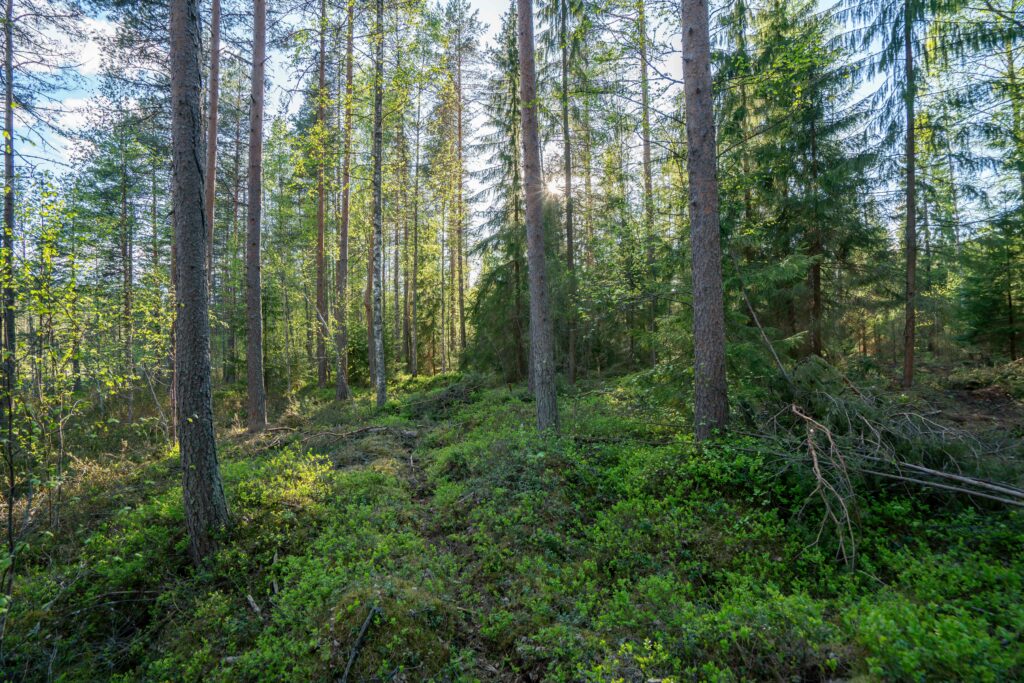21.07.2025 | Case story
Selective harvesting of trees can preserve biodiversity, maintain carbon-sequestration capacity and reduce nutrient runoff into the sea. The Finnish organisation Metsän jatkuvan kasvatuksen yhdistys Silva is helping to show forest owners the economic and environmental benefits of this technique with a grant from the Baltic Sea Action Plan Fund.
Forestry has been one of the most important industries in the Nordic region for thousands of years. Despite millennia of experience, foresters are still learning improved ways of working.
“Typically, forest owners in the Nordic region harvest their trees by clear cutting,” explains Sampo Manninen, Co-founder and Chair of Silva ry 2019-2025. “This can have major consequences on soil nutrients, humus and water retention, which can negatively impact downstream water quality.”
Land cleared of trees releases nitrogen and is the third-largest source of phosphorous loading in water. The result is eutrophication, a process in which an overabundance of nutrients causes algal blooms. When the algae die, decomposer microbes consume so much oxygen they create dead zones in the Baltic Sea where neither plants nor fish can live.
Continuous Cover Forestry
“The problem of nutrient runoff from agriculture is well known and being addressed through various projects and programmes, but there has been much less focus on forestry,” says Dennis Hamro-Drotz, Acting Head of Department, Special Funds at Nefco. “We thought Silva had an interesting project addressing this topic.”
Continuous Cover Forestry (CCF) is the selective harvesting of trees, while leaving the rest standing. This encourages multigenerational forests with a greater variety of species, leading to a more resilient ecosystem. It also means that young seedlings grow as a result of natural regeneration instead of expensive re-planting and ensures the biodiversity of forests is better preserved. The use of CCF can reduce nutrient runoff into the Baltic Sea.
The scientific community has published many studies regarding the benefits of CCF, but this information is not well known to forest owners. Silva wanted to gather this information and communicate it to them, so they applied to the Baltic Sea Action Plan (BSAP) Fund and were approved for financing.

Funding projects to help the Baltic
The fund provides financing, typically grants, to support the goals of HELCOM’s Baltic Sea Action Plan, the strategic programme to improve the environmental health of the Baltic Sea. Currently, funding is provided by Sweden and Finland.
“A healthy Baltic Sea is important for everyone who lives in the surrounding area. The BSAP Fund is cross-boundary and projects can be implemented in more than one Baltic Sea country,” Hamro-Drotz says. “The Silva project took place in Finland but is relevant for the entire Baltic Sea watershed.”
Forest Calculator shows concrete benefits
One result from the project is the free, online Forest Calculator. Finnish forest owners can input details of their land and the tool returns financial and environmental data to show the benefits of CCF. It uses public forest resource data and combines it with research from collaborating organisations like the University of Eastern Finland and the Natural Resources Institute Finland (Luke).
“The Forest Calculator gives results for a specific property, based on the soil types and ages of the trees,” Manninen continues. “It was critical to develop a simple, accessible and reliable tool that is easy to use and understand.”
Based upon Silva’s research, CCF lowers phosphorous load by about 50 per cent and nitrogen load by about 60 per cent annually, compared to clear-cutting. The improvements are dramatic in the first 20 years, while the relative benefit reduces in later decades. CCF appears to have a better result in reducing nutrient runoff in mineral-rich soil compared to peatlands, but it is still better in all cases.
A better environment for everyone – from campers to squirrels
“I believe CCF’s benefits to biodiversity are even greater than its CO2 sequestration benefits,” Manninen says. “Leaving continuous forest cover is also important for recreation and tourism. Trees are important for our wellbeing. Some studies show that we live longer if we have trees in our neighbourhood.”
By widely disseminating the potential benefits of CCF to local decision-makers, the Forest Calculator has the potential to greatly scale the practice to the benefit of the Baltic Sea and everyone living in the surrounding area. Funding from the BSAP Fund was instrumental in getting the tool developed and popularised.
“I value the role of Nefco and the Nordic Investment Bank highly in this overall process,” Manninen says. “A Nefco representative came to our launch event for the Forest Calculator. They were active and interested.”
Continued advocacy for CCF to come
Promoting CCF was not a one-off project for Silva. It is now taking lessons learned to the forest industry and European officials to advocate for CCF to an even wider audience.
“I first used CCF in my forests in 2016, and my neighbours were amazed at how much wood was produced while still leaving some trees standing,” Manninen says.
“I am optimistic for the future of CCF. We are currently adding new tools and details to the Forest Calculator and are working on some more big projects.”
Sampo Manninen, Co-founder and Chair of Silva ry 2019-2025
Text: David J. Cord
About the BSAP Fund
The Baltic Sea Action Plan Fund (BSAP Fund) was set up in 2010 to help speed up the implementation of BSAP, adopted by the HELCOM countries in 2007 to create a healthier Baltic Sea. The key purpose of the BSAP Fund is to facilitate and speed up the preparation of projects by both public and private entities. As of the end of 2023, the BSAP Fund had funded 74 projects ranging from nutrient recycling to the removal of microplastics. The fund is co-managed by the Nordic Investment Bank (NIB) and Nefco with contributions from Sweden and Finland.
For more information, please visit the Baltic Sea Action Plan Fund webpage.
Contact us

Project in short


